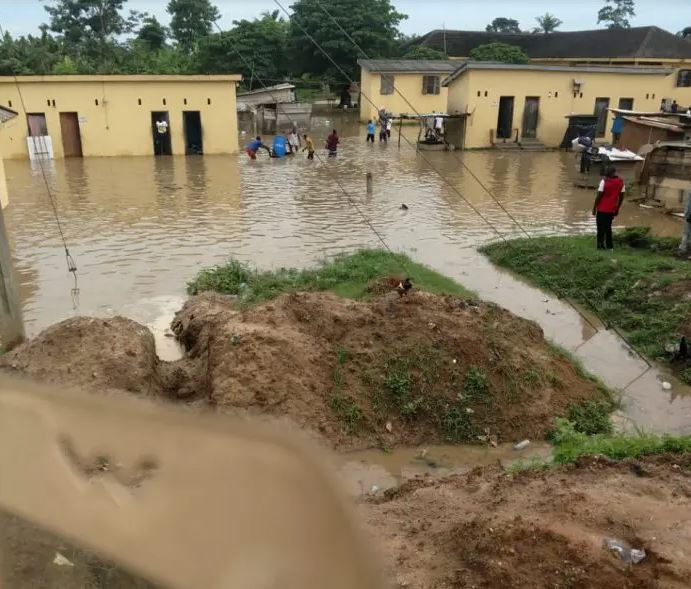Prepare for more rains – NADMO cautions
The Director-General of the National Disaster Management Organization (NADMO), Eric Nana Agyeman Prempeh, has warned the public to brace themselves for more rains in the coming days.
He said water will always find its way, which could be destructive, so people should remove all structures on waterways to allow free flow.
In the past weeks, continuous rains have caused havoc in different parts of the country, with several properties getting destroyed and hundreds of people displaced.
“There are going to be more rains in the coming days, so let us all be mindful of our activities in this season,” he said while visiting flood-affected areas in the Central Region after a spillover on Saturday, 18 June 2022.
More than 100 houses in the Komenda Edina Eguafo Abirem Municipality, including the Ankaful Camp Prison, were submerged after some rivers overflowed their banks.
The heavy rains started last Friday night to Saturday dawn, cutting off the bridge linking Cape Coast and Twifo Praso at Jukwa.
Nana Agyeman Prempeh visited Abaye, Simiw, Nkotoado, and adjoining communities in the Komenda-Edina-Eguafo-Abbrem (KEEA) municipality, as well as Ankaful, where 77 officers have been displaced and one dead.

He assured of his outfit’s commitment to collecting data for swift action.
“Relief items have been dispatched to support victims as preliminary measures,” he added.
Meanwhile, the Central Regional Minister, Justina Marigold Assan, and the Member of Parliament for Twifo Hemang Lower Denkyira, Bright Wereko Brobey, have urged victims to remain calm as authorities work to provide more relief items.
Road infrastructure damaged
At Jukwa, a greater portion of the bridge linking Cape Coast and Twifo Praso was washed away.
The road was split into two when a section completely caved in, rendering the route inaccessible for motorists.
The Elmina-Takoradi highway was also flooded, just like some roads at Dompoase in the Komenda Edina Eguafo Abirem (KEEA) Municipality.
Buildings collapsed in some communities, including Essiam, Simiw, Abee, Effutu, Dompoase, Brase, and Ntranoa.
Drivers are advised to drive cautiously in order to avoid any disaster.
Destruction by floods
Many lives have been lost and properties destroyed due to the annual floods.
In 2011, floods in the country resulted in the death of more than 30 people nationwide, with 15 victims in Accra.
In 2015, 159 people were confirmed dead from a twin disaster of floods and fire explosion.
It was one of the deadliest catastrophes to befall the country, leading to days of mourning as families lost their loved ones.
A fire explosion occurred after several hours of rain and flooding around the Kwame Nkrumah Interchange enclave.
In June 2020, a man died trying to warn neighbours about flooding at Odawna in Accra.
A resident explained that the deceased was trying to salvage some items during the flooding when he was electrocuted.
At Achimota, a bus was trapped in a storm drain. It was not carrying passengers. At least 20 persons were rescued from that incident after a downpour that lasted hours.
Flooding in Accra has also killed people and displaced people in the city in 1995, 1997, 2001 and 2010.
Interventions by authorities
For many Ghanaians, the annual ritual of the capital city flooding has become a cause of anger.
Efforts by the city authorities to check the situation continue to be undermined by recalcitrant residents and the weak enforcement of bye-laws.
The government has attempted to address this problem by dredging rivers and gutters before rainy seasons, but this appears to be ineffective.
In May 2019, President Nana Akufo-Addo inspected two major projects handed out in 2016 to Dredge Masters Limited for the desilting and dredging of the Odaw channel and restoration of the Korle Lagoon to avert the perennial flooding in Accra.
The scope of work also included the redesign and construction of the KLERP interceptor and breakwater at the outfall.
The channel under the scope starts from the Odaw Onyasia confluence at Carprice in Accra, through Avenor, Kwame Nkrumah Interchange, and the Agbogbloshie-South Kaneshie drain (the Upper and Lower Lagoon).
The two projects the president inspected were the Accra Sanitary Sewer and Storm Water Drainage Alleviation Project at Circle and the Drainage Construction at Kaneshie 1st Light Intersection.
Other causes of floods are the improper planning of settlement in Accra, choked gutters that block the drainage system and a few other human factors.



